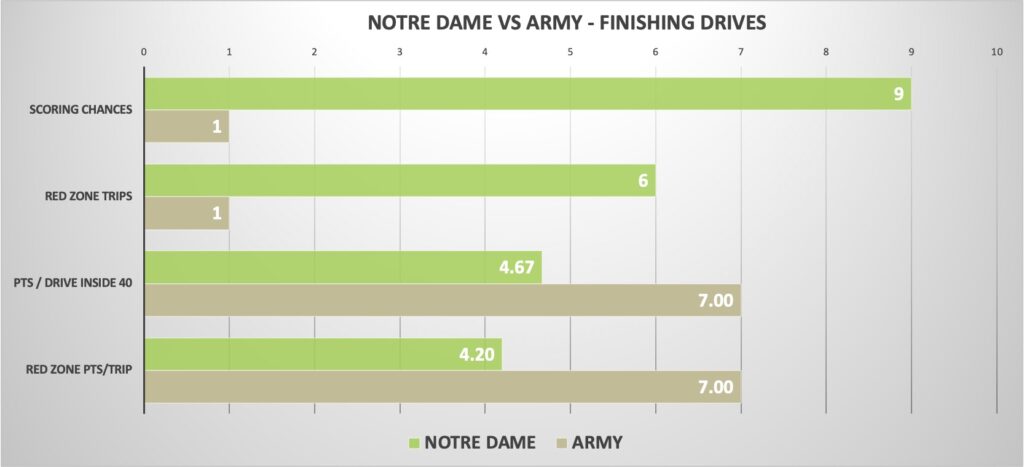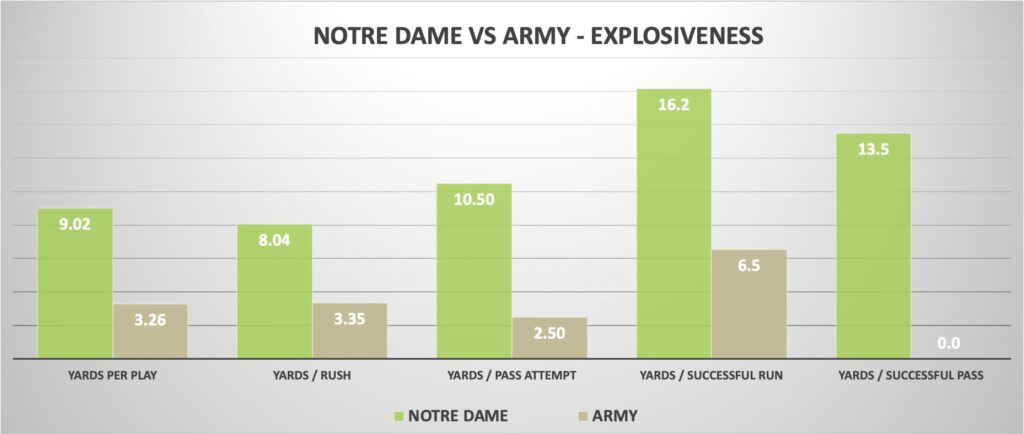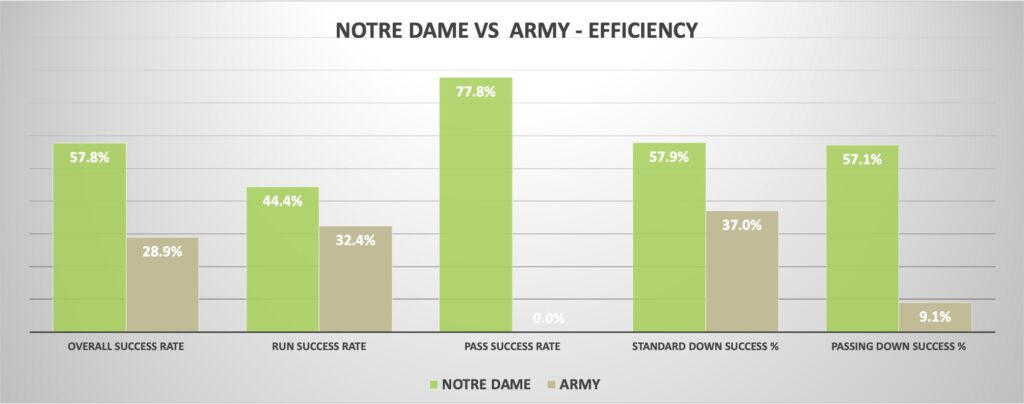When Miami (Florida edition) dropped Notre Dame from the 2024 schedule late in the process (as scheduling goes), the Irish pivoted to hosting Army. Everything after that point turned into the ideal outcomes Marcus Freeman’s team, with the Black Knights entering the game undefeated and incredibly ranked #19 in the CFP rankings and Notre Dame exiting Yankee Stadium with a dominant win.

There are unavoidable parallels to the Navy game, but this was a more impressive defensive performance. Instead of capitalizing on opponent mistakes, the Notre Dame defense physically dominated (3.26 yards per play before garbage time) without the benefit of many turnover chances. The ND offense similarly moved the ball at will against Jeff Monken’s defense, creating scoring chances on every possession, never punting, and with the only failures coming with some stalled goal line and kicking chances.
Garbage time for this game starts with 0:45 left in the 3rd quarter, when Jadarian Price’s second touchdown put the Irish up 42-7. These numbers are incredibly entertaining though – in garbage time Army ran 29 plays for 109 yards (3.76 YPP). Excluding Steve Angeli’s end of game kneel down, the Irish ran just one play for Aneyas William’s 58-yard TD.
A near-perfect offensive performance

Notre Dame wasn’t far off from completing what Parker Fleming (maybe better known as @statsowar) calls the “golden Eckel”. The Eckel rate, similar to CORSI in hockey, measures quality possessions (or scoring opportunities). A golden Eckel is a perfect performance – every possession generates a scoring chance inside the opponent 40 and is converted into a touchdown.
Before garbage time, Mike Denbrock’s unit nailed the first part – nine drives, nine quality possessions. There were just close failures – a failed 4th down attempt at the goal line (on a brutal goal-to-go series featuring several Riley Leonard runs up the middle) and a missed Mitch Jeter field goal attempt (where you could make a strong argument for just going for it, but I understand the desire for an in-game health check for the kicking game).
Outside of those blips, the Irish offense was exceptionally efficient and explosive, through the air and on the ground. If anything, Notre Dame’s rushing numbers are understated because of a few possessions of goal-to-go clunkers. On rushing plays inside the Army 10-yard line, Notre Dame had an 11% success rate (1/9) and 0.6 yards per carry. All other runs? A 61% success rate and 11.8 yards per rush.

How concerning are those goal-to-go failures? Not very, and hopefully it was a quick lesson for Mike Denbrock in a game where it didn’t matter. But before this game, Notre Dame had been successful on 16/21 (76.2%) runs in these goal-to-go situations. It may have been an opponent-specific strategy that Denbrock and Leonard couldn’t exploit, or a putting something on tape for the future. But I’d trust that the Irish strength in the red zone observed all season should continue.
A complete shutdown of Army’s offense

Navy and Army aren’t copy and paste option offenses, but the difference in the defensive output from those two games is striking. Against the Midshipmen, the Irish defense was gashed for a few explosive plays en route to 6.4 yards per play and a 40% success rate. Al Golden’s defense applied pressure, no doubt, but the Midshipmen had a ton of unforced fumbles that gifted easy ends to drives.
In Yankee Stadium, there was simply nothing available for the Black Knight offense. Army had just 3.4 yards per carry, and averaged 8.0 yards to gain on 3rd down. Bryson Daily and company had just one explosive play – the 19-yard rush where Leonard Moore forced a fumble that Jack Kiser recovered.

It was a very quiet game statistically in terms of turnovers and havoc. While there were tons of hard hits laid by the Irish defense, there still weren’t a ton of tackles for a loss and just the single forced fumble.
IU and Auburn show the value and blind spots for analytics
A quick side observation – to me, Indiana’s loss to Ohio State perfectly illustrated some of the blind spots and challenges of advanced stats systems. You’re probably tired of this debate about the Hoosiers, but the analytics behind it are fascinating to me. Because when a team does what Frank Cignetti’s team had done before going to Columbus – overwhelmingly dominating a fairly weak schedule, even if one filled with P4 teams – how are the numbers supposed to distinguish IU from Oregon? Or what Ohio State would have done against those same teams?
The rating systems can only evaluate what you’re doing against the teams you play. Destroying opponents is meaningful. But at some point there’s an inability to distinguish truly great teams from those capable of dominating the middle class until those spider webs of top teams finally connect with each other. While it’s frustrating, this is also why preseason projections typically remain an important predictive feature of these systems until very late in the year. They provide a reasonable anchor based on historical performance and talent to tether teams to in the absence of a big enough samples or strong enough competition, as irrational as that may seem at times.
The Auburn result felt like the opposite side of that coin – a matchup against Texas A&M where a traditional, record-based approach would assume the Aggies would be substantially favored. Vegas – which of course, it using its own proprietary systems to set lines – sniffed out the hidden quality of the Tigers despite their struggles and place in the standings. “Vegas knows” is more fun, but this is really the numbers sniffing out the potential for an upset that was far more likely than our narratives for each team would suggest.
On to USC
The biggest game of the Marcus Freeman era deserves some extra attention, so going deeper into the numbers to preview USC via video this week. I hope its insightful – both showing how you can break down some of these numbers before a game and to provide an in-depth overview of the Trojans.





Michael, top notch breakdown of the stats…thank you
Very well done
Thanks MB
Felt like the best shellacking of a supposedly good opponent since we beat the tar out of Syracuse at Yankee Stadium six(!!!!!) years ago.
That syracuse game had a really nice final score shine to it, but the game was a grind. This was so much more dominant. Nd was over +6 YPP. I don’t believe nd had any 3rd downs not in scoring territory this past weekend.
That syracuse game had a ton of empty possessions and was kind of a slog. I remember being concerned about books health in that game too post rib Injury
I hope we get to play Miami in the playoffs, or even better yet, Clemson wins the ACC and we get Miami at home in the first round.